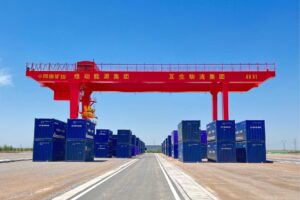By Nick Harrison, partner and head of consulting at management consultancy, Vendigital.
The world is more connected than ever before, and the challenges of the future are ones that we will have to face together. Climate change is one such challenge and has the potential to cause severe disruption to global supply chains if directors do not plan proactively against it. Whilst manmade disasters, such as the Ever Given container ship blocking the Suez Canal, demonstrate how easily a single disruption can deeply affect global shipping infrastructure, multiple disruptive climate events occurring simultaneously in different locations have the potential to be even more devastating for businesses.
The effects of climate change can already be seen throughout the globe. Droughts in China have disrupted energy supplies to hydropowered factories and caused temporary halts in production for some products, and the floods in Pakistan have impacted not only the businesses located there, but also the supply chains of its neighbours.
It is important to understand that these problems are not going to go away, and businesses will have to adapt to survive. As temperatures rise, the habitable areas of the globe will constrict, and people will naturally migrate to more temperate climates. As such, factories may find themselves without an adequate workforce, or spending uncapped sums on air conditioning in order to make the workplace fit for purpose, ironically further contributing to climate change. Rising sea levels are also set to have a global impact on shipping routes and population migration, which could be catastrophic considering the amount of product that is shipped around the world.
These real-world impacts should push climate change to the top of every board agenda, and the successful companies of the future are the ones who will begin to gather data on this subject and make decisions based on the predicted impact sooner rather than later. To ensure that the effects of climate change are mitigated as far as possible, there are two approaches to be taken on a global and individual level.
The first, global approach confronts climate change as a mega-trend, and seeks to foster a collaborative environment to mitigate its effects. This will be done by examining each part of a product’s journey, from creation to distribution, and seeking to implement green initiatives where possible to reduce carbon emissions. Directors could take steps to power factories with renewable energy such as nuclear or biomass and ensure that there is a commitment to reducing waste, for example.
Next, each part of the supply chain could be examined to understand where green efficiencies could be made, for example by utilising electric vehicles to move a product between the factory and the port, or electric planes to transport products. These areas will need investment, as electric vehicles are currently unable to travel as far on a single charge as those that are powered by fossil fuels, however, the impact of these vehicles on the carbon emissions of the global supply chain has the potential to be world changing.
On an individual level, directors can use data to calculate the carbon emissions across their supply chain and take steps to reduce it. Through the intelligent use of data to map where key suppliers are and what risks they may face, directors can begin to create plans to mitigate disruption should disaster strike. To do so, it is vital to build climate change into risk registers. This will sit alongside other risk registers such as financial, strike and industrial action and corruption and violence, with the data used to inform strategic development and mitigation such as implementing dual sourcing practices.
Whilst the climate cannot be controlled, utilising meteorological data sources and local data mapping for example, will help to create a red/amber/green alert system across global facilities, showing which are at high risk from climate change impacts. This data allows directors and chief operating officers (COOs) to make informed decisions when creating alternative or contingency supply strategies. By using data to make strategic decisions in advance of a risk, for example by moving from an area where drought will become more common, directors and COOs can build resilience into each part of their supply chain in the face of seemingly uncontrollable forces.
Climate-related challenges are not going to subside unless swift action is taken by all parts of the supply chain. Building resilience into the infrastructure of supply chains is key, as if it is not fit for purpose, it won’t be able to cater for demand and will create delays. However, with the advancement of electric vehicles speeding up, and more directors aware of the impact of climate change on their businesses than ever before, the picture remains a hopeful one. With some joined-up thinking from the beginning to end of a product’s lifecycle, and by implementing and utilising accurate data to understand where the impacts of climate change will be felt most, businesses can successfully mitigate the risks for the future, and perhaps even contribute to a greener world overall.






